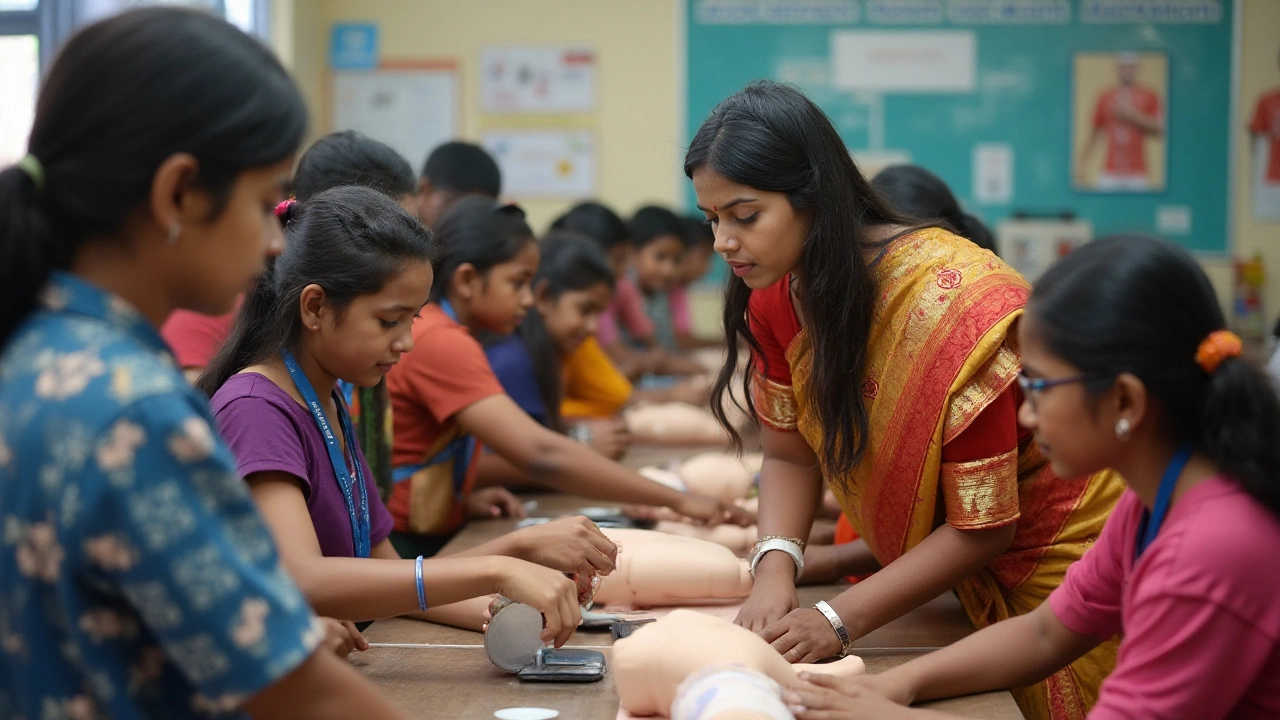Types of Vocational Training: A Comprehensive Guide

We live in an era where practical skills often hold the key to professional success. With its roots embedded in real-world applications, vocational training provides a unique opportunity for individuals to gain specialized knowledge and enter specific industries equipped and ready. While traditional education focuses on a broad-based academic approach, vocational training emphasizes hands-on learning tailored to fast-evolving job markets.
In this article, we'll delve into the significance of vocational training and explore various fields that offer this form of education. Whether you're considering a career change or aiming to enhance your job skills, understanding the landscape of vocational training can pave the way to achieving your career goals. Let's embark on this journey to uncover how vocational education can transform career trajectories and open doors to diverse opportunities.
- Understanding Vocational Training
- Popular Vocational Training Fields
- Benefits of Vocational Education
- How to Choose the Right Vocational Course
- Comparing Vocational and Traditional Education
- Future Trends in Vocational Training
Understanding Vocational Training
Vocational training has emerged as a critical component of modern education, designed to equip individuals with the necessary skills and specific knowledge relevant to particular trades or careers. Unlike traditional educational pathways, which often focus on theoretical knowledge across various subjects, vocational courses deliver direct hands-on experience. This tangible approach to learning ensures participants gain applicable skills quickly. Vocational training is essentially about building a skilled workforce suited for employer demands, and it's tailored to meet those specific needs.
Vocational programs are diverse, encompassing fields such as technology, healthcare, culinary arts, and more. Many vocational schools provide students with the opportunity to practice in real-world settings, enhancing their competency through immersive experiences. For example, students pursuing courses in the automobile industry might spend time in workshops or garages, learning from seasoned professionals. It is this real-world application that sets vocational education apart. Interestingly, according to the National Center for Education Statistics, about 18% of all degrees awarded in the United States are in vocational fields, highlighting their growing popularity.
"Vocational education redefines the balance between education and practical skills, effectively bridging the gap between learning and work readiness," says John Smith, an expert in educational development.
The history of vocational training dates back to the Industrial Revolution when the need for skilled labor increased significantly. It was during this time that structured training became integral to prepare workers for specific roles within rapidly mechanizing industries. Even today, as technological advancements continue to evolve, the demand for updated and refined vocational skills remains high. The infusion of technology into vocational education has also made learning more effective and accessible, with numerous online platforms offering simulations and virtual training experiences.
Why Choose Vocational Training?
One might wonder why someone would opt for vocational training over a more traditional education path. The answer lies in its practicality and efficiency. With the rapid advancement of industries, a significant number of employers now seek candidates who possess immediate skills rather than just theoretical knowledge. Vocational courses offer learners a competitive edge by allowing them to acquire industry-specific skills faster. Additionally, many vocational programs are shorter and less expensive than traditional college degrees, making them an attractive option for those looking to enter the workforce without accumulating substantial debt. Not to mention, vocational training often leads to certifications or diplomas that are recognized and valued by employers worldwide.
Popular Vocational Training Fields
Vocational training spans across a plethora of industries, each offering its own unique set of skills and opportunities. These courses are designed to provide students with the practical expertise needed to thrive in their chosen fields. One of the most in-demand areas is healthcare, where vocational courses cover essential roles such as nursing assistants, dental hygienists, and pharmacy technicians. These programs focus heavily on hands-on practical training, which is crucial for understanding patient care and medical procedures. It's not surprising that healthcare continues to be a popular choice, given its significant growth and stability in the job market.
Expanding into the realm of technology, vocational training is essential for those pursuing careers in IT support, network management, and software development. The rapid pace of technological advancements means continuous learning is key, and vocational courses offer the means to stay up-to-date. For example, coding boot camps and certificate programs can equip students with the skills needed for roles such as web developer or cybersecurity analyst. As this field evolves, vocational training serves as a gateway to acquiring cutting-edge skills and knowledge.
Trade professions represent another cornerstone of vocational education. Electricians, plumbers, and carpenters are in high demand, thanks to the ongoing need for construction and maintenance in both urban and rural areas. These positions typically require a combination of classroom learning and apprenticeships, allowing students to get a taste of real-world work environments under expert supervision. Such vocational courses are perfect for individuals who enjoy hands-on projects and derive satisfaction from constructing or repairing tangible objects in our everyday lives.
The culinary arts field offers a savory option for those with a passion for food, with vocational courses ranging from pastry arts to restaurant management. Such programs often blend theoretical knowledge with experiential learning, where students take part in kitchen labs, gaining first-hand experience in food preparation, presentation, and culinary creativity. As noted by James Beard Foundation, "The future of food relies on a new generation of passionate and skilled chefs who are trained innovatively and practically." This quote highlights the central role vocational training plays in shaping tomorrow's culinary experts.
Manufacturing and automotive industries also rely heavily on vocational training. With the rise of automation and sustainable practices, new vocational programs focus on teaching modern techniques, such as the repair and maintenance of electric vehicles or robotics operations in manufacturing plants. A recent report highlighted that approximately 70% of manufacturing roles require technical skills, making vocational training vital in preparing a skilled workforce ready to meet changing industry demands.
Lastly, creative fields like graphic design, photography, and film production offer exciting vocational opportunities for those with artistic flair. Such courses provide not only the technical skills needed to excel but also nurture the creative process itself. In this rapidly visual world, graphic designers and visual media specialists are crucial in shaping content across different platforms. Training in these fields often involves extensive work with industry-standard software, ensuring students' readiness for the dynamic demands of creative industries.

Benefits of Vocational Education
Vocational training, offering a distinct alternative to conventional academic pathways, has gained recognition for its significant benefits that cater to diverse learners. One of the key advantages is its practical approach. Unlike traditional education, which often focuses on theoretical knowledge, vocational education immerses students in real-world scenarios. This hands-on experience fosters a deeper understanding of job-related tasks and equips learners with the skills required to excel in specific careers from the onset. For example, a student in a culinary arts program won't just learn about cooking techniques but will also engage in preparing meals regularly as part of their curriculum. Through such direct application of knowledge, students build confidence and competence, bracing themselves to meet the expectations and demands of the workforce.
The rapid nature of skill acquisition is another compelling reason why many favor vocational courses. These programs are designed to be concise and targeted, often allowing students to complete their education and enter the workforce faster than those pursuing four-year degrees. This speed is particularly attractive in industries where qualified workers are in high demand, such as healthcare, technology, and skilled trades. According to a study published by the National Centre for Vocational Education Research in Australia, individuals completing vocational training find employment opportunities at a rate comparable to or higher than those holding traditional degrees in several sectors. Vocational programs also align closely with industry needs, ensuring that the skills taught are those sought by employers, thus enhancing job placement rates.
"Vocational education plays an essential role in meeting the demands of a global economy by equipping the next generation with the skills required for cutting-edge industries," notes John S. Allen, a renowned advocate for skill-based learning.
An often-overlooked benefit of vocational education is the financial aspect. Not only is vocational education frequently more affordable than a university degree, but it also allows graduates to begin their careers and start earning an income much sooner. This early entry into the job market can result in significant cumulative earnings over a lifetime. Additionally, some industries offer apprenticeship programs, where individuals can earn while they learn, offsetting the cost of education and minimizing student debt. These financial incentives make vocational training a sound choice for many young individuals and even mid-career professionals seeking a change.
An engaging aspect of vocational training is its adaptability. Education providers continuously update the curriculum to reflect changes in technology and industry practices. This flexibility ensures that the training remains relevant and prepares students to tackle the challenges and opportunities that arise amid rapid technological advancements. Moreover, vocational education often includes a variety of learning modes, from classroom instruction to workplace experiences, catering to different learning styles and preferences. With a focus on practical skills and adaptability, vocational training institutions ensure that their graduates remain competitive in an ever-evolving job market.
The societal impact of vocational education cannot be overlooked. By fostering a skilled workforce, vocational programs contribute to economic development and innovation. These training pathways also provide opportunities for individuals who may not thrive in traditional educational environments to find gratifying careers. In 2023, statistics highlighted that vocational training enrolment boosted Australia's skilled labor force significantly, contributing positively to various economic sectors. As more individuals recognize the merits of skill-based education, the path of vocational training reaffirms its place as a vital component of the contemporary educational landscape, enhancing both individual prospects and broader societal growth.
How to Choose the Right Vocational Course
Selecting the right vocational training is an important decision that can significantly shape your career path. To navigate this journey successfully, it’s crucial to begin with a keen self-assessment. Understanding your interests, strengths, and the types of activities you enjoy can provide valuable insights into potential vocational fields that suit your personality. Some people thrive in creative roles, where they can innovate and express ideas freely, while others may find fulfillment in more structured environments that demand technical precision. When you're aware of your personal inclinations, tailoring your educational path becomes much easier.
Consider the future demand for the skill set you aim to acquire. Analysts and industry experts release forecasts that show which industries are expected to grow, presenting lucrative opportunities for skilled professionals. For instance, the healthcare sector consistently reveals an upward trend due to an aging population, suggesting that training in areas like medical assisting or elder care promises job security and growth. Digging into labor market information can protect your investment of time and resources into a field where skills are both needed and valued.
"Success is where preparation and opportunity meet." — Bobby Unser
Another step in selecting the appropriate course is investigating the qualifications and accreditations of the institutions offering such training. Credibility matters, as a recognized certification not only increases your employability, but also validates the quality of the education received. Seek out reviews from former students and employers who have engaged with graduates from the program. Feedback from these sources can provide an unfiltered look at the effectiveness of the training.
It's also beneficial to weigh the formats of learning that best fit your lifestyle and commitments. Vocational courses can be completed through full-time study, part-time classes, or even online formats. Each mode has its advantages; full-time courses offer immersive experiences, while part-time or online options might provide the flexibility needed to balance education with other responsibilities. Ultimately, the right choice depends on your individual situation and learning preferences. If possible, approach alumni or current students for advice, as they can offer a perspective grounded in direct experience.
To add a practical layer to theoretical knowledge, verify if the program includes hands-on training or internships. These experiential components are vital, carving out real-world skills and allowing you to apply what you’ve learned in a controlled, supportive environment. Employers value candidates who not only have the theoretical groundwork, but also the practical proficiency to hit the ground running. Programs that integrate internships and practical placements offer a distinct advantage over others.
Factors to Keep in Mind
- Self-assessment of interests and skills.
- Industry growth forecasts and labor market needs.
- Institution accreditation and reputation.
- Learning format flexibility.
- Incorporation of practical experience.
Lastly, consider the financial implications of course selection. Research scholarships, grants, and other types of financial aid that can ease the burden of tuition costs. A financial plan is indispensable, ensuring that your educational ambitions remain sustainable and within reach. By taking all these factors into account, choosing the right vocational course becomes less of a daunting task and more of an exciting challenge—an important step towards shaping a career that aligns with your aspirations and opportunities in the vocational courses arena.

Comparing Vocational and Traditional Education
When it comes to education, the paths of vocational training and traditional academic routes reflect distinct philosophies about learning. Vocational training is centered around the idea of teaching job skills that can be directly applied to specific industries. This practical and hands-on approach is a stark contrast to traditional education, which often takes a more theoretical perspective, diving deep into subject matters that are meant to provide a broad understanding of a given field.
A critical difference between these two forms of education lies in their duration and structure. Traditional education, such as bachelor's degree programs, generally spans four years, during which students engage with a variety of subjects, some of which may not relate directly to their career goals. In contrast, vocational courses are designed to be completed in a shorter time frame, ranging from a few months to two years. This accelerated pathway means that students can enter the workforce much more quickly, equipped with the specific skills required by employers.
The Value Proposition
Many students find vocational training economically appealing as it tends to be more affordable than traditional college degrees. The cost efficiency extends beyond tuition, taking into account the shorter time commitment, which correlates to less time spent out of the workforce. When evaluating the return on investment, vocational training can offer a good deal of value, especially for careers in high-demand industries like healthcare, IT, and skilled trades such as plumbing or electrical work.
Another factor to consider involves the teaching styles and learning environments prominent in each educational path. Vocational training typically emphasizes experiential learning, where students learn by doing – this often includes internships, apprenticeships, or practical courses. In contrast, traditional education places a strong emphasis on lectures, textbooks, and research, which can seem abstract to learners who thrive on engagement and tactile experiences.
"Vocational education and training are an innovative solution, as they provide people with skills that meet the genuine requirements of the labor market." - European Centre for the Development of Vocational Training
This quote reflects a growing understanding that the skills imparted by vocational courses are finely tuned to meet labor market needs. This alignment can be a decisive factor for students evaluating between the hands-on practicality of vocational training and the broad academic focus of traditional education.
Career Outcomes and Flexibility
The efficacy of vocational training compared to traditional education is often judged by the career outcomes each produces. Vocational routes may lead directly into employment with ample room for growth and specialization. Specialized training like IT certifications can also offer flexibility, providing credentials that allow for a variety of career advancements without necessitating a return to school for additional degrees. Traditional education, however, often provides greater mobility across professions, given its comprehensive approach that cultivates critical thinking and analytical skills.
Ultimately, the decision between vocational and traditional education depends on individual priorities and career aspirations. The modern job market values diversity in skills and adaptability, underscoring the importance of aligning personal education goals with career ambitions. Whether one opts for vocational courses or traditional pathways, the key is to invest in an education that opens the right doors to personal and professional fulfillment.
Future Trends in Vocational Training
In a rapidly changing world where technology and industry needs evolve at an unprecedented pace, vocational training must adapt to remain relevant. One notable trend shaping the future of vocational education is the integration of digital technologies into the learning process. With the advent of Industry 4.0, interactive tools like virtual reality (VR) and augmented reality (AR) are revolutionizing the way skills are taught. These technologies offer immersive learning experiences that were previously unimaginable, allowing students to simulate real-world environments and complex tasks from the safety and comfort of a classroom.
Another emerging trend is the synergy between vocational training and green technologies. As industries worldwide pivot towards sustainable practices, there is a growing demand for workers skilled in renewable energy, sustainable agriculture, and eco-friendly construction methods. Vocational courses are increasingly incorporating these topics into their curricula, preparing students for a future where sustainability is paramount. This shift not only benefits the environment but also provides graduates with job security in sectors poised for growth.
The structure of vocational courses is also changing. There's a significant movement towards micro-credentialing, where students can achieve certification in specific skills rather than completing longer courses. This allows for tailored education, meeting the precise needs of employers while enabling learners to advance their careers without the extended commitment traditionally associated with education. Organizations like the OECD highlight how such models of learning are expected to become mainstream, as they offer flexibility and efficiency in developing job-ready skills.
According to a report by Deloitte, "Vocational education will play a critical role in equipping the workforce to meet the demands of future economic structures. The blend of core academic principles and practical hands-on applications provided by vocational courses positions them as a cornerstone of modern education."
With the rising popularity of online learning platforms, vocational training is becoming more accessible than ever before. Students across the globe can now enroll in courses provided by institutions situated thousands of miles away, without leaving their home country. This global reach enhances cultural exchange and allows for a diverse learning environment where different techniques and perspectives are shared.
As the job market becomes increasingly competitive, vocational courses are also placing a stronger emphasis on soft skills. Employers are not just seeking technical prowess—qualities like communication, teamwork, and problem-solving have become equally important. Training programs are now incorporating modules that focus specifically on these skills, ensuring that graduates emerge well-rounded and ready to contribute effectively to any workplace environment.

